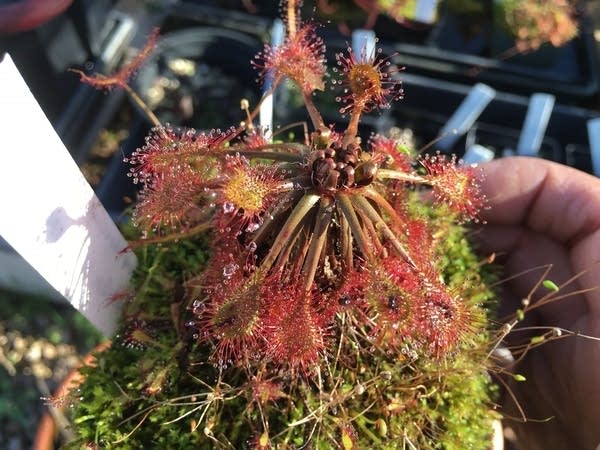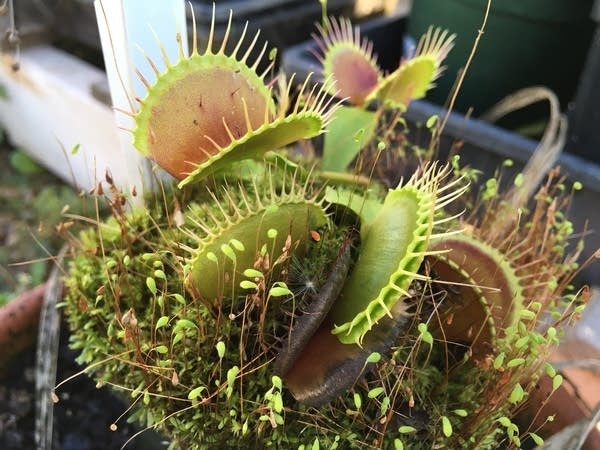Most plants get the energy and nutrients they need from water, sunlight, air and soil. But carnivorous plants get key nutrients from a different source: bugs.
We’ll find out how they do it and talk about the mystery of how venus fly traps snap shut.
Plus: Two gardeners – one very experienced and one just starting out – offer their tips for growing venus fly traps.






Audio Transcript
Download transcript (PDF)
CASSIDY: My name is Cassidy and I live in Chino Hills and I'm seven years old and I'm in second grade.
MOLLY BLOOM: Cassidy grows Venus Flytraps.
CASSIDY: Yes, I do.
MOLLY BLOOM: And what do these fearsome organisms look like?
CASSIDY: You know plants that have leaves, let's just imagine there's a butterfly there that makes a little "V", and then there's points on the butterfly's little wings, that would be it. That'd be a Venus Flytrap.
MOLLY BLOOM: OK. So maybe fearsome isn't the best word to describe these carnivorous plants, but they are super cool. And Venus Flytraps are just the tip of the iceberg.
RICKY GARZA: Yeah there's Venus Flytraps, there's Pitcher Plants, there's the Cobra Lilies, Bladder Warts, a lot of those are actually aquatic. And their traps are very similar to the Venus Flytrap in that they're rapid action traps, but very tiny and they're underwater so people don't see them too often. So we've got those, and we've got Sun Dew's, and there's also Butter Warts.
MOLLY BLOOM: Ricky Garza is a horticulturist and gardener at the Minnesota Landscape Arboretum. He says carnivorous plants are found in wet, boggy places.
RICKY GARZA: And these places are hard to walk in. You could sink in the muck pretty quickly so they're not very human friendly environments. But the plants find their little niche there.
MOLLY BLOOM: And these places also have acidic soil, which is a problem. Generally, plants get all the nutrients and energy they need from water, sun, air and soil. But this acidic soil doesn't have the nutrients that plants require, particularly, nitrogen. So carnivorous plants have found a workaround. They get that nitrogen from bugs. And carnivorous plants use some pretty nifty tricks to convince insects to land on them.
RICKY GARZA: So part of it's the color and part of it is they have little nectar sources, they are dewdrops that they lure them in on that tasty little surprise for the insect.
MOLLY BLOOM: Once the plant has lured an insect with a tasty meal, the next step is to trap it. Different carnivorous plants do this in different ways. Sun Dew's trap the insects between sticky, pin-like stalks. Butter Warts use a similar sticky substance to trap insects on their leaves. And Pitcher Plants are shaped like wells that are very hard to get out of.
RICKY GARZA: The edge is very slippery and they wind up slipping slightly down into the Pitcher Plant. Beyond that smooth spot, there are downward pointing hairs, they actually get stabbed by these little hairs so they're forced basically lower and lower down into the pit.
MOLLY BLOOM: And then there's the star of the carnivorous plant world, the Venus Flytrap. The reason they get the most attention is because the way they trap their meals.
CASSIDY: You know those hairs are on it? Flies go on to the Venus Flytrap, right? Then it has to touch two trigger hairs and then it'll close right up. It's kind of like a sensor.
MOLLY BLOOM: Exactly. So picture a clamshell, or like Cassidy described it, butterfly wings. Before the Venus Flytrap catches an insect, it's open. Inside the two halves are six trigger hairs. If an insect touches two of the trigger hairs within 20 seconds, it's snap shut. And it snaps shut quickly, like fraction of a second quickly.
RICKY GARZA: People are just amazed that a plant can move that rapidly. Whether you're young or old, I think it's fascinating.
MOLLY BLOOM: We'll talk about the mystery of how they move so fast in a minute, but first, we need you to do some lightning fast thinking. It's time for the mystery sound.
[TUNE]
(WHISPERING) Mystery sound.
[THEREMIN TUNE]
Here it is.
[HIGH-PITCHED HONKING NOISE]
We'll be back with the answer after this. Marc and Sanden are planning a debate for later this fall. We asked for your topic suggestions and you came through with so, so, so many that we could not pick. We narrowed down the list to 10. And now we need you to vote for your favorite. Just head to Brainson.org to tell us which match-up you want Marc and Sanden to tackle. Will it be-- oh, cool. I get to use the announcer voice again-- mountains versus oceans, fire versus lasers, left brain versus right brain, salt versus sugar, outer space versus deep sea, vertebrates versus invertebrates, solar power versus wind power, day versus night, chocolate versus vanilla, or sharks versus dolphins? You have until October 1 to vote.
Now it's time to announce the most recent group to be added to the Brains Honor Roll. These are the kids who keep us going with their questions, suggestions, mystery sounds and high fives.
[LISTING HONOR ROLL]
Let's get back to the Mystery Sound. Let's hear it one more time.
[HIGH-PITCHED HONKING]
Any guesses? Well, here's the answer.
CATALINA: Hi, my name is Catalina. And that was the sound of the frogs behind our house in Florida.
MOLLY BLOOM: Thanks for sending in that mystery sound, Catalina. And now from one bug eater to another, let's get back to carnivorous plants. Alden and Nevada from Leavenworth, Washington have this very excellent question.
ALDEN: How does Venus flytraps move? Since they are plants, they do not have muscles.
MOLLY BLOOM: It turns out it's still something of a mystery. Scientists aren't exactly sure what's happening after that trigger, but many think that it has something to do with water pressure inside the plant.
RICKY GARZA: There's a rapid change in water pressure that's inside the leaf and actually the tip of the leaf grows very quickly. The leaf blades on the Venus Flytrap go from being convex to being concave. And that action makes the flytrap close.
MOLLY BLOOM: So a change in water pressure causes a change in the shape of the leaf, snapping the cage shut. Now we know how they lure the bugs and how they trap the bugs, but what puts the carnivore in carnivorous plants?
SOLOMAN: My name is Solomon. And I live in Ponca City, Oklahoma. My question is, how do Venus Flytraps seed flies? They don't have a throat to swallow them.
MOLLY BLOOM: And they don't have a stomach to digest them. But they do have something else that we have, digestive juices. When a Venus Flytrap closes, it secretes acid and enzymes that break down the insect so the plant can absorb the nutrients inside. This process takes somewhere between 5 and 12 days. Once it's done, the trap opens back up, the wind or rain sweeps away the remaining exoskeleton and the trap is ready for a new bug.
Generally, each trap closes about 10 to 12 times before it's no longer able to do that anymore. Then it stays open to help the plant with photosynthesis for two to three months and then the plant can grow new traps to replace the old ones. Many other carnivorous plants also use these digestive juices to get nutrients from insects, but there are a few species that use something else. Something we humans also have in our guts, microorganisms.
RICKY GARZA: The Northern Pitcher Plant doesn't have the digestive fluids and they actually rely on other microbes in the pitcher to break down the insect to make it more readily absorbable.
MOLLY BLOOM: Just like Cassidy, Ricky first started getting interested in carnivorous plants when he got his first Venus Flytrap as a boy. And just like Ricky, Cassidy has come to care a lot about her little collection.
CASSIDY: It's like your own mini garden. And well, now that I think about it, it's kind of fun seeing how good it grows, it's kind of like, you know, kids, like, it's kind of like kids growing up with a plant.
MOLLY BLOOM: If you're interested in raising your own Venus Flytrap, here are some tips from Cassidy and Ricky.
CASSIDY: I got my first one last year. That one kind of died, but then we bought a couple more. So we have six now.
RICKY GARZA: Most of them like full sunlight, warm temperatures and pure water.
CASSIDY: I accidentally put the water that we drink into it on accident. I forgot. You're only supposed to use distilled water or else they'll die.
RICKY GARZA: One thing about the Venus Flytrap, it needs a dormant period. So that would mean putting it in your refrigerator, lower 30s to upper 30s during the winter for about two or three months. They only live in a 100 mile circumference area that straddles North and South Carolina. And that's their global population. And their habitat is diminishing very rapidly. So it's important that if you're going to have a plant to know that it was responsibly grown and not collected or harvested from the wild.
MOLLY BLOOM: The world of carnivorous plants is diverse and fascinating, full of sticky, slippery traps, digestive enzymes and microorganisms on land and under water, big and small. OK, that's enough of that. But these plants really are super cool and have adapted to live in a place where most plants can't. Head to our website to see some photos from the carnivorous plants that Ricky has raised at the Minnesota Landscape Arboretum. And you'll see a video of a Venus Flytrap in action.
[CLAPPING TUNE]
That's it for this episode of Brains On. You can email us your questions mystery sounds and high fives to BrainsOn "@" "M", as in Minnesota, P, R .org, or you can find our mailing address at our website, BrainsOn.org. While you're there, you can listen to all our past episodes, sign up for our newsletter and vote for the match-up you want Marc and Sanden to debate. You can also keep up with us on Instagram and Twitter, we're @Brains_On, and there's always Facebook too. Thanks for listening.
Transcription services provided by 3Play Media.



